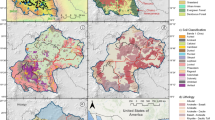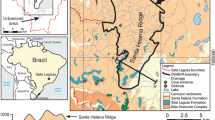Abstract
Estimation of groundwater recharge is extremely important for proper management of groundwater systems. Many different approaches exist for estimating recharge. The main purpose of this paper is to apply a water balance concept with two methods to estimate the groundwater recharge in the Ching-Shui watershed, Taiwan. First, a soil moisture budget method is established to estimate the infiltration, runoff, evapotranspiration, and groundwater recharge in the watershed, where the moisture content of the soil is tracked through time. Both soil–water properties of the unsaturated zone and climatic conditions must be fully considered. Second the base-flow model uses the base-flow separation from the total streamflow discharge to obtain a measure of groundwater recharge so that groundwater evapotranspiration is negligible. In contrast to the soil moisture budget method, base-flow estimation does not require complex hydrogeologic modeling and detailed knowledge of soil characteristics. In a previous study, we suggested that high base-flow is caused by rainstorm events. Using model analysis, depths of recharge estimated by stable-base-flow analysis are adopted to obtain more reasonable groundwater recharge values. The results indicate that assessment of the average annual recharge obtained with a soil moisture budget and the base-flow are very close; the ratio of the two methods is about 95.3%.










Similar content being viewed by others
Abbreviations
- A :
-
parameter related to sorptivity (L1/2)
- A i :
-
drainage area (L2)
- a :
-
infiltration constant (–)
- D :
-
diffusivity (L2 T)
- d r :
-
depth of water reservoir (L)
- E :
-
evapotranspiration flux (L T−1)
- E p :
-
potential evapotranspiration rate (L T−1)
- h :
-
the depth of annual recharge (L T−1)
- i :
-
infiltration rate (L T−1)
- k :
-
unsaturated hydraulic conductivity (L T−1)
- k s :
-
saturated hydraulic conductivity (L T−1)
- N :
-
time base of surface runoff
- P :
-
rainfall intensity (L T−1)
- Pcum(t):
-
cumulative rainfall (L)
- R gw :
-
annual groundwater recharge (L3 T−1)
- S :
-
sorptivity (L T−1/2)
- t :
-
time (T)
- t e :
-
equivalent time to ponding (T)
- t p :
-
ponding time (T)
- q :
-
unsaturated water flux (L T−1)
- q cumie (t):
-
amount of infiltration excess runoff (L T−1)
- q cumse (t):
-
amount of saturation excess runoff (L T−1)
- q r :
-
recharge flux (L T−1)
- ϕ :
-
effective saturation (–)
- ϕ 0 :
-
initial effective saturation (–)
- λ :
-
pore size distribution index (–)
- θ :
-
volumetric water content (–)
- θ 0 :
-
initial volumetric water content (–)
- θ r :
-
residual water content (–)
- θ s :
-
saturated water content (–)
- ψ :
-
soil pressure head (<0 if soil unsaturated) (L)
- ψ s :
-
air entry value (L)
- ψ 0 :
-
initial soil pressure head (L)
References
Allen RG, Pereira LS, Rase D, Smith M (1998) Crop evapotranspiration Guidelines for computing crop water requirements. FAO Irrigation and Drainage Paper 56. FAO, Rome
Arnold JG, Allen PM (1999) Automated methods for estimating baseflow and ground water recharge from streamflow records. J Am Water Resour Assoc 35:411–424
Avery WJ, Donovan J, Ketchum N (1999) Recharge estimation by stage-discharge interpretation from cross-correlated well measurements. Ground Water 37:332–337
Barnes BS (1939) The structure of discharge recession curves. Trans Am Geophys Union 20:721–725
Brooks RJ, Corey AT (1964) Hydraulic properties of porous media. Hydrology Papers 3 Colorado State University, Fort Collins
Central Weather Bureau (1992–2001) Yearbook of climate. Central Weather Bureau, Taiwan
Chen WP, Lee CH (2003) Estimating ground-water recharge from streamflow records. Environ Geol 44:257–265
Chen JF, Lee CH, Yu JL (2003) An analytical solution on water budget model in unsaturated zone. J Chin Inst Eng 26:321–332
Chen JF, Lee CH, Yeh TCJ, Yu JL (2005) A water budget model for the Yun-Lin plain, Taiwan. Water Resour Manage 19:483–504
Cherkauer DS, Ansari SA (2005) Estimating ground water recharge from topography, hydrogeology, and land cover. Ground Water 43:102–112
Chiang WH, Kinzelbach W (1998) Processing Modflow for windows (version 5.06) Hamburg
Delin G, Healy RW, Landon MK, Bohlke J (2000) Effects of topography and soil properties in recharge at two sits in an agricultural filed. J Am Water Resour Assoc 36:1401–1416
Fillion E, Noyer ML (1996) Flow modeling in a dual porous domain with automatic mesh generation and parameter calibration: application to the Aespoe site. J Hydrol 180:1–19
Gehrels H, Peters NE, Hoehn E, Jensen K, Leibundgut C, Griffioen J, Webb B, Zaadnoordijk WJ (2001) Impact of human activity on groundwater dynamics. IAHS Publication, pp 269
Horton RE (1933) The role of infiltration in the hydrologic cycle. Trans Am Geophys Union 14:446–460
Ketchum J, Donovan J, Avery W (2000) Recharge characteristics of a phreatic aquifer as determined by storage accumulation. Hydrogeol J 8:579–593
Kohlmeier M, Massman J, Wulkau M, Ziefle G (2007) Rockflow 5, User Manual, Keyword Description-Institut fuer Stroemungsmechanik. Leibnitz Universitaet Hannover
Kulandaiswamy VC, Seetharaman S (1969) A note on Barnes’ method of hydrograph separation. J Hydrol 9:222–229
Lee CH, Chen WP, Lee RH (2002) Estimate ground-water recharge of Taiwan from base-flow-record method J Taiwan Water Conserv 50:54–66 (in Chinese)
Lee CH, Chen WP, Lee RH (2006) Estimation of groundwater recharge using water balance coupled with base-flow-record estimation and stable-base-flow analysis. Environ Geol 51:73–82
Linsley RK Jr, Kohler MA, Paulhus JLH (1982) Hydrology for engineers. 3rd edn. McGraw-Hill, New York
Louie M, Shelby P, Smesrud J Gatchell L, Selker J (2000) Filed evaluation of passive capillary samplers for estimating ground water recharge. Water Resour Res 36:2407–2416
Mau DP, Winter TC (1997) Estimating ground-water recharge from streamflow hydrographs for a small mountain watershed in a temperate humid climate, New Hampshire, USA. Ground Water 35:291–304
McDonald MG, Harbaugh AW (1988) A modular three dimensional finite difference ground-water flow model. US Geological Survey Techniques of Water-Resources Investigations
Mein RG, Larson CL (1973) Modeling infiltration during a steady state rain. Water Resour Res 9:384–394
Nathan RJ, McMahon TA (1990) Evaluation of automated techniques for base flow and recession analysis. Water Resour Res 26:1465–1473
Olmsted FH, Hely AG (1962) Relation between groundwater and surface water in Brandywine Creek Basin, Pennsylvania. US Geological Survey Professional Paper 417-A, 21p
Otto R (2001) Estimating ground water recharge rates in the southeast Holstein region, northern Germany. Hydrogeol J 9:498–511
Parlange JY, Hogarth WL, Barry DA, Parlange MB, Haverkamp R, Ross PJ, Steenhuis TS, DiCarlo DA, Katul G (1999) Analytical approximation to the solution of Richards’ equation with applications to infiltration, ponding, and time compression approximation. Adv Water Resour 23:189–194
Philip JR (1957) The theory of infiltration, 4, sorptivity and algebraic infiltration equation. Soil Sci 84:257–264
Pruess K, Oldenburg C, Moridis G (1999) TOUGH2 User’s guide, Version 2.0, Lawrence Berkeley Lab. Rep. LBNL-43134 UC-400, Berkeley
Rutledge AT (1992) Methods of using streamflow records for estimating total and effective recharge in the Appalachian Valley and Ridge, Piedmont, and Blue Ridge physiographic provinces. In: Hotchkiss WR, Johnson AI (eds) Regional aquifer systems of the United States, aquifers of the southern and eastern states. Am Water Resour Assoc Monogr Ser 17:59–73
Rutledge AT (1993) Computer programs for describing the recession of ground-water discharge and for estimating mean ground-water recharge and discharge from streamflow records. US Geological Survey. Water Resources Investigations Report 93-4121, 45p
Rutledge AT (1998) Computer programs for describing the recession of ground-water discharge and for estimating mean ground-water recharge and discharge from streamflow records-update. US Geological Survey Water-Resources Investigations Report 98-4148, 43p
Rutledge AT (2000) Considerations for use of the RORA program to estimate ground-water recharge from streamflow records. US Geological Survey Open-File Report 00-156, 44p
Rutledge AT, Daniel CC III (1994) Testing an automated method to estimate ground-water recharge from streamflow records. Ground Water 32:180–189
Szilagyi J, Vorosmarty CJ (1997) Modeling unconfined aquifer level reductions in the area between the Danube and Tisza Rivers in Hungary. J Hydrol Hydromech 45:328–347
Yeh HF, Chen JF, Lee CH (2004) Application of a water budget model to evaluate rainfall recharge and slope stability. J Chin Inst Environ Eng 14:227–237
Yeh HF, Lee CH, Chen JF, Chen WP (2007) Estimation of groundwater recharge using water balance model. Water Resour 34:171–180
Zektser IS (2002) Principles of regional assessment and mapping of natural groundwater resources. Environ Geol 42:270–274
Zhang L, Dawes WR, Hatton TJ, Reece PH, Beale GTH, Packer I (1999) Estimation of soil moisture and groundwater recharge using the TOPOG_IRM model. Water Resour Res 35:149–161
Acknowledgments
The authors are grateful for the support of the Research Project of the National Science Council (NSC92-2625-Z006-013).
Author information
Authors and Affiliations
Corresponding author
Rights and permissions
About this article
Cite this article
Lee, CH., Yeh, HF. & Chen, JF. Estimation of groundwater recharge using the soil moisture budget method and the base-flow model. Environ Geol 54, 1787–1797 (2008). https://doi.org/10.1007/s00254-007-0956-7
Received:
Accepted:
Published:
Issue Date:
DOI: https://doi.org/10.1007/s00254-007-0956-7




